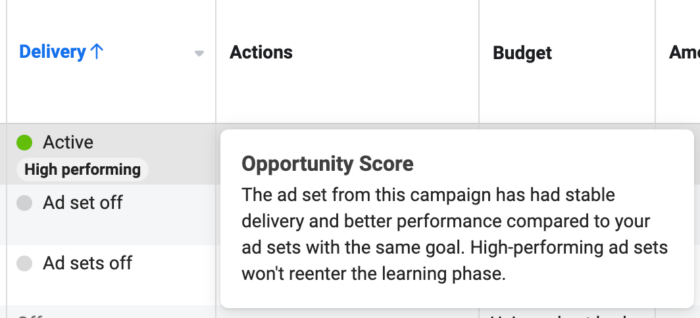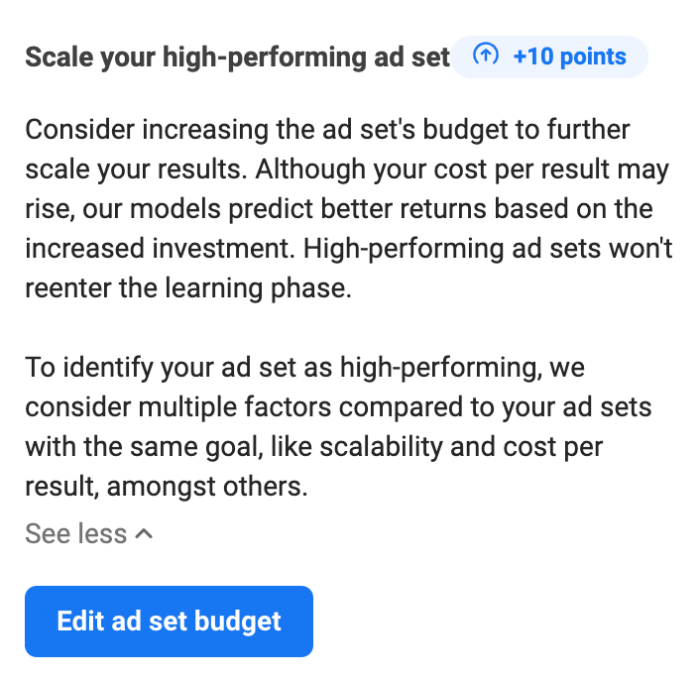There have been several recent changes to Meta Sales campaigns that could be hugely impactful, if not transformational. It only makes sense to dedicate a post to highlight them.
In some cases, these are official changes or new features. In others, they are updates that have been spotted in the wild, but Meta hasn’t yet declared them as official changes.
Additionally, I should point out that some of these only apply to Sales campaigns while others apply to one or more other objectives.
In this post, you’ll learn about the following:
- Audience Segments for ALL Sales Campaigns
- A New Learning Phase
- Scale High Performing Ad Sets
- Schedule Individual Ads
- Ad Sources and Site Links
Let’s go…
1. Audience Segments for All Sales Campaigns
I spotted this one when creating a Sales campaign recently, and I’m pretty excited about it.

I included the option to turn on Advantage Campaign Budget in the screenshot so that you can see that this is for a manual Sales campaign, not for Advantage+ Shopping. That’s what makes this novel.
One of the benefits of Advantage+ Shopping Campaigns is this special reporting feature. Once you define your Engaged Audience and Existing Customers audience segments, you can get deeper insights into your reporting. More on that in a moment.
There is an Audience Segments portion of your Ad Account Settings (it may be in your Advertising Settings). This is normally for Advantage+ Shopping Campaigns only, but now it explicitly states that “these settings apply to all sales campaigns in this ad account.”

You’ll need to define your Engaged Audience and Existing Customers.
Your Engaged Audience should be people who have engaged with you but have not bought. I use my email list and website visitors to define this group. Do not worry about excluding people who have purchased from you (I’ll get to that in a minute).

Your Existing Customers are those who have bought from you. I use specific website custom audiences and email segments to define this.

If a person is found in both audience segments, they will only be considered among Existing Customers.
Now, here’s what’s so great about it. One of the potential issues with Advantage+ Shopping Campaigns is that since targeting is entirely algorithmic (you don’t provide targeting inputs), there can be a lack of trust regarding who sees your ads and how they’re delivered. Once you define these groups, you get transparency in your reporting.
When you use the Breakdowns dropdown menu and select By Demographics > Audience Segments…

…you’ll get a separate row for Existing Customers, Engaged Audience, and New Audience.

Back to manual Sales campaigns. This same transparency was needed when using Advantage+ Audience or any of the Advantage audience expansion products. How much is spent on reaching my remarketing audience? How much is spent on existing customers? How much on prospecting to completely new people?
This will not only give you a breakdown of how your money is spent, but where the results come from. That’s insanely helpful.
I’m still holding out hope that Meta will eventually make this available for all campaign objectives. It’s necessary.
2. A New Learning Phase
There are actually two changes related to the Learning Phase that advertisers have spotted recently that could be enormously helpful.
You’re probably familiar with the Learning Phase as the period of time, after publishing a new ad set or making a significant edit, when Meta’s ad algorithm is learning how best to deliver your ads for optimal results.
Typically, that has meant needing 50 optimized actions within a seven-day period (usually the first seven days since publishing). If you are unable to reach that volume, you’ll find yourself in “Learning Limited,” which may prevent you from getting optimal results.

While this might be reasonable for most actions, it’s going to be difficult for the typical brand or advertiser to get 50 conversions in a week when that conversion is a purchase — especially if it’s a high value purchase. As a result, advertisers either avoid optimizing for purchases or they get what is likely sub-optimal results.
That could be changing. Many advertisers have reported seeing a new Learning Phase that requires 10 conversions in three days.

This is huge. While the window is shortened, this only requires getting a little more than three sales per day — rather than the seven that were required previously. If you struggled to exit the Learning Phase in the past, this gives you a very reasonable chance now.
Note that I haven’t seen anything indicating that this is an official change yet. As I type this, Meta’s documentation still reflects the need for 50 conversions. But, this is at least a test.
I should also note that I’ve noticed some of my ad sets never enter the Learning Phase at all now. They immediately enter Active status. It’s not clear to me when or why this is the case, but it seems that the Learning Phase is much more forgiving now and may require less data to exit than it once did.
What’s happening here? Why is it that the Learning Phase is shortening — and in some cases not happening at all? This appears to reflect that Meta has more or better data to more quickly determine how to optimally deliver your ads. This is more than likely related to improved machine learning and AI.
3. Scale High-Performing Ad Sets
The Learning Phase is the source of a great deal of frustration, and even fear, among advertisers. They’re reluctant to make any significant changes, including scaling the budget, because it may restart the Learning Phase.
The reason for that frustration is that “learning” typically means unstable and less predictable results. If you’re getting great results that are consistent from day to day, it’s reasonable to not want to rock the boat.
Well, one of the updates allows you to increase your budget without restarting learning. If you ever see “High Performing” in the delivery column of an ad set, it qualifies for budget increases that immediately return to Active.

Meta will even give you a scale of recommended increases and the projected number of results you should expect.

While you’ll see diminishing returns the more you spend, it’s good to know that you won’t see any negative impact to the stability of performance.

This added transparency should help advertisers better plan their ad spend and take advantage of high performing ad sets without the fear of restarting the learning phase.
4. Schedule Individual Ads
Normally, the schedule to run your ads is determined within the ad set. This means that your ad schedule applies to all ads within it. But, you can change that with a new update that is rolling out.
When you create a manual Sales campaign with the Website conversion location, you may see a “Show More Options” link below Multi-Advertiser Ads within the Ad Setup section.

Click it and you’ll see a “Schedule” option.

Hover over this area to get the option to edit. You can then set a start and optional end date for your ad.

The ability to schedule individual ads was previously a unique option found within Advantage+ Shopping Campaigns. But, now we’re seeing this surface in manual Sales campaigns, too.
This allows you to schedule individual promotions for ads rather than manually stopping and starting them or creating separate ad sets. If you created an ad set to promote a specific product, you could schedule an ad that reveals a sale price that coincides with a promotion. This could especially be helpful for seasonal promotions, like during Black Friday and Cyber Monday.
There are many ways you might use this. You could conceivably create an ad set that promotes various similar products, but schedule when each product gets promoted.
5. Ad Sources and Site Links
Meta is rolling out the ability to include links to other important information under your ad creative. The end product looks like this…

Notice the scrollable links below the ad creative? Those are controlled by the advertiser.
The following settings are required:
- Sales, Traffic, Engagement, or Leads objective
- Website conversion location
- Manual upload using single image or video
Within ad creation, you should see an Ad Sources section.

You can optionally provide a website URL and Meta will automatically attempt to source some site links.

Click “Review and Confirm.” You can review the site links that Meta found.

In the example above, Meta automatically pulled links to two of my products and three subscriptions. While they are great suggestions, Meta also uses the full page title, which I wouldn’t want to use.
Click “Set Up Manually.”
You need at least three site links to display them on your ad. Include a display label and URL. When you’re done, click Save.

You should then see confirmation that the site links were added.

You can also use your product catalog to display individual products or categories of products.

You can view what this will look like by pulling up the Advanced Preview and filtering by Advantage+ Creative enhancements. There should be one for “Add Site Links.”

How should you use site links? Meta has a recommendation:
You can use the site links feature to highlight different categories, products, deals, sign-ups, and your other most visited landing pages within one campaign. Ads with site links can help provide more opportunities for people to learn about your business, products, and services and achieve conversions more easily.
Don’t feel like you need to be boxed in by this recommendation as a guideline. Get creative.
Something that immediately came to mind for me was promoting blog posts and videos on my website. Normally, the entire focus is getting that traffic and engagement. But, now I can add site links to get a secondary registration or purchase because it’s highlighted in the ad.
Something that isn’t yet clear to me is how easily conversions from site links can be tracked to these ads. It’s like any other situation related to attribution, except that the “results” won’t necessarily be tied to the site links. This is where adding extra columns for execution of conversions related to your site links could be necessary.
Your Turn
Lots going on right now, and these are all some pretty amazing updates for Meta Sales campaigns. Do you have any favorites?
Let me know in the comments below!






